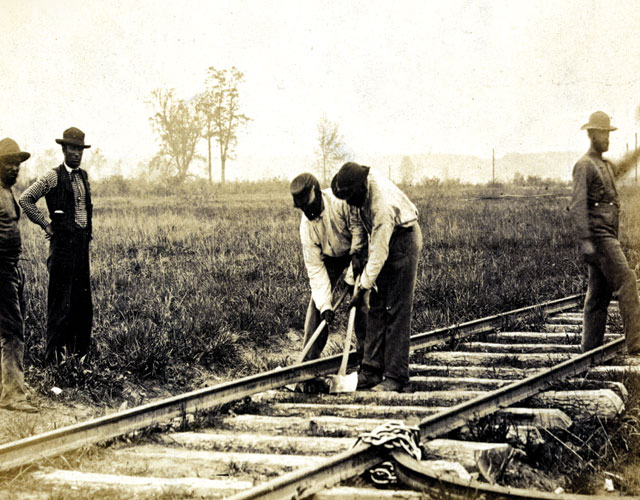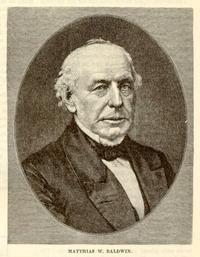 Chains of Misery: The Dark, Infernal Engine of Oppression
Chains of Misery: The Dark, Infernal Engine of Oppression
In a typical attempt to rewrite history, most, though not all, books written on the railroad tend to gloss over or even ignore entirely the shameful practice prevalent in the southern states of America during the early years of its creation. While slavery had been a dark part of man’s history for hundreds of years, by the nineteenth century most countries had outlawed and banned it, with a few exceptions, America of course being the most prominent. They must surely have known their time had come, but the southern states of America clung to their belief in, and their perceived right to slavery like the last ragged gasps of a hated old man dying, with nobody to miss him and nothing left to live for, refusing to die, holding on to life just for spite. It was, and had become, a way of life for them, and generations had grown up knowing no other way, but it would be churlish to suggest they resisted because they didn’t know any better. Of course they did.
But without going into a whole treatise on the idea of slavery itself, as I already noted in another section, it seems to me that I owe it to the memory of all those brutalised, killed, raped and whose freedom was trampled on as if it were nothing to remember them and report the dreadful conditions in which they laboured. Seen as nothing but property of course, they were hired out to the railroad companies by the plantation owners, and hey, if they didn’t return, who cared? The slave bosses could always buy more slaves. So there was really little to keep the construction foremen from working the slaves to death, all in the name of progress and, more importantly, profit. And, naturally (!), of showing the black man his proper place.

This may account for the poor quality of the railroads built there, and their limited success. Quite apart from the misery of being a slave, I imagine it is hard to motivate one to work on a project on which they are forced to labour. In the northern states, men would work on the railroad with a sense of pride, a feeling of accomplishment, a desire to be part of history. And, of course, for money. Slaves would know that the railroad was for whites only, that they would never ride it, that it would never be of benefit to them, that all it would do, in essence, would be convey the fruits of their backbreaking toil to the ports for sale. Hard to get excited or patriotic about such an endeavour.

Of course, there were the terrible working conditions to take into account too. White men on the northern railroads might think they were hard done by and poorly paid, but slaves weren’t paid at all, and while free men could go on strike - or threaten to - to increase wages, such avenues were not open to the slave. Not that he needed them, since, as I’ve just said above, he didn’t get paid. But that wasn’t in any way the worst of it. With no regard for their safety and no care for their wellbeing, railroad bosses forced the workers to endure the harshest of regimes, feeding them food that was little better than offal (when they fed them at all), leaving them prey to attack by insects, snakes, wild beasts and diseases in the swamps and jungles through which they rammed their rails. Scarlet fever, cholera and malaria swept through the camps, which were not much to speak of in terms of accommodation. Here’s an example.
The Atlantic & North Carolina Railroad kept the slaves “in a square pen, made of pine poles, through which one might thrust his double fists, [with] no shutter on the door . . . no chimney and no floor, no bed clothing and no cooking utensils.” In fact, the conditions were known to be so bad that plantation owners often turned down large sums in exchange for hire of their slaves, not because they feared for their safety, but because they didn’t want to lose their valuable property. Considering how bad life on the plantations was, it’s telling that many slaves preferred (not that they had a choice) to remain there rather than go into the service of the railroad companies.
After they lost the Civil War, with the Emancipation Proclamation forcing them to free their slaves, southern states made covert deals among each other and had prisoners shuttled over borders and pressed into work gangs to labour on the railroad. They may have been treated marginally better than the slaves, though not much.
Although most railroads in the north crossed from state to state, it was a different matter down south, where each state ruled that its railroad stay within the boundaries of its own state. Most of these were short, slow and badly built, and serviced the cotton industry, running from plantations to ports, with not too much interest by the state in the line carrying passengers.
In the north (and presumably the south too) fears of the burgeoning new technology were allayed by almost homily-like dissertations on how the railroad would cure everything from poverty to homelessness, provide people a better life and a brighter future, and how everything good would come of it, and nothing bad. Of course, along with those promises came, as in the church, the outstretched hand, as people were asked to invest their paltry savings in this or that railroad, not all of which prospered, though many did.
A rather prescient prediction, however, that was to come true came in 1832 from a writer on railroad matters, Charles Caldwell, when he spoke in glowing terms of a state which was at the time little more than a mostly uninhabited swamp, and declared that the railroad would soon be ““enabling and inducing invalids, and people of feeble constitutions, to migrate from the south to the north, in summer, and from the north to the south, in winter.” A man somewhat ahead of his time, it would seem. Railroads were to be seen, too, as the great leveller, as the rich and the poor should both be able to afford to travel on them (whether the idea of different classes of travel on the trains - a virtual segregation by class - was envisaged at this time or not I don’t know), though it was quietly agreed that this situation might not suit the more well-off, who might be offended at having to share the same train as those below their social station, no pun intended.

 Ironsides and Bullseyes: Isaac Dripps, Matthias Baldwin and the birth of the American locomotive
Ironsides and Bullseyes: Isaac Dripps, Matthias Baldwin and the birth of the American locomotive
American railroads owe much to a young engineer who, without any plans for one and without ever having seen such a thing before, assembled in a matter of weeks the John Bull, a Stephenson locomotive that had been shipped to the US in parts. He then became chief engineer of the Camden & Athboy Railroad, and set about improving the design of the John Bull, then designing his own locomotives. He added many features, including something unique to US trains, the cowcatcher. This, it must be said, was a heinously cruel attachment, originally intended to impale any cattle who wandered onto the unfenced track, and later to knock them out of the way, but whichever method was chosen, the cow or bull or sheep or ox was not going to survive the impact. The cowcatcher did not catch cows at all, but slew them, and its inventor had no interest in saving or protecting the cattle, merely ensuring that impact with them did not derail the train.
Another amateur engine designer, a jeweller by trade, Matthias Baldwin had put together an engine as a hobby, and was asked by the owner of a museum to build a small locomotive to pull around some cars in a display in the museum. Local railroad bosses saw it, and approached Baldwin to make a locomotive for them. He produced “Old Ironsides”, a big, heavy, slow machine that often needed the assistance of horses as it regularly rocketed around at one mile an hour, but he worked on it and made improvements, and was soon in the business of making locomotive engines. In a relatively short space of time, American locomotives took on distinctive characteristics that set them apart from the British and European ones, such as wide chimney stacks with sparkcatchers to reduce the likelihood of fires being started by stray sparks and cabs for the crew. The wider wheels too, vital for transport along the wider and heavier American rails, helped make the engines more robust, true workhorses, and they in time attained a grace of their own that bordered on their being seen as works of art.
Carriages, however, were another matter. The first ones were nothing more than old stagecoach bodies on flat trucks linked together by loose chains, and jerked and buffeted the passengers so badly that few early trips ended without bruises and the odd bout of concussion. People carrying umbrellas, in the hope they would protect them from the smoke, found them catching fire and also being whisked over the side by the violent motion of the train. One difference, however, between European and American carriages was the lack of any first-class, or other class segregation, as all carriages (called cars in America) were open and without compartments. This did not always suit passengers, as people liked their privacy, but one thing remained, even in the supposedly liberal north: black people had to travel in their own carriages and were not allowed mix with the whites.
In contrast to Britain and Europe, American railroads worked on the principle of “build ‘em fast and cheap and get ‘em earning”, which meant inferior materials were used, less tunnels bored and less stations built, and of course little attention given to safety issues, something which would come back to haunt the American railroads down the line. Sorry. But while there were now railroads in operation in the US, it wasn’t anything like a network, with small lines running from this town to that mine, and no further, or slightly larger lines serving one or two towns directly along its path. I suppose they could all but be called local or even internal lines; services that provided transport from a specific place to a specific place, often with no stops along the way, bringing to mind the vision of a child’s toy train set running endlessly round in circles, or down a straight lenght of track, unable to go anywhere once it reached the end and having to be returned to its starting point, the locomotive version perhaps of a shuttlecock constantly going from one fixed point to the other, and back.
Although the railroad began to take America by storm between the late 1830s and the early 1840s, it was new technology, and like all new developments people weren’t quite sure where it was going exactly. Many saw it as a novelty, a day out, somewhere to take the kids - wagon to the train station, ride the train to its terminus (next town probably, or some point within the same town even) and back, then hop into the wagon and home. Few actually envisaged it as any sort of potential replacement for their wagons, and almost nobody foresaw the idea of not only towns but cities being linked by the iron horse, much less a national network that would, in time, stretch right across the country from coast to coast. What happened in 1837 did not help matters.